Home »
Blogs
»
Bhopal: Energy Efficiency through Smart Streetlights
Bhopal: Energy Efficiency through Smart Streetlights
February 16, 2021
Author:
jitendra_singh_rathore
Problem Statement
- Streetlights are essential elements of a municipal environment and services. They affect residents’ sense of safety while influencing a city’s ability to create an inviting environment for business and tourism. Bhopal, undertaking a conscious effort of becoming a green and clean city, needed ways in which energy could be conserved and used efficiently.
- Many surveys were conducted in order to understand and analyze the problems related to streetlights. One of these surveys was ‘Women Safety Pin Survey’ which helped to identify the dark spots in the city which needed to be illuminated by the street lights.
- The conventional lamps used for street light were a major source of power consumption.
- Other challenges with conventional lamps included high replacement costs, low quality light, disposal issues, etc.
Thus keeping energy efficiency in mind, a cost effective alternative was needed for the streets which would not compromise citizen’s safety.
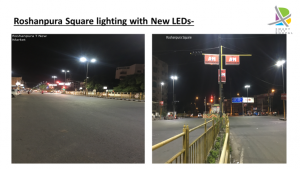
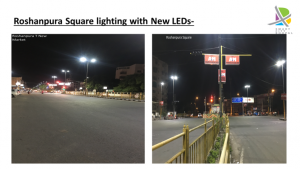
Solution
For this project these LED lights were mounted on street poles each having a control system that was integrated with the central control and command center for monitoring and controlling smart services:
- The street lights under this project were automated as compared to earlier conventional sodium street bulbs.
- A Video Wall was established as the necessary IT infrastructure and EMS for monitoring the LED street lights.
- Each LED light was installed with a luminaire controller having an astronomical clock to define lighting schedules based on seasons.
- The Luminaire Controller stores scheduled ON, OFF and stepless dimming command that it received from the Central Management.
- The Luminaire Controller is able to manage the luminaire even in case of a network outage (i.e. the stored lighting schedule applies even if the controller can’t communicate with the Central Management System).
- Also this Luminaire Controller has the ability to be managed remotely.
- A dedicated control room has resulted in individual as well as collective monitoring of the street lights resulting in efficient and prompt action in case of any problems.
- The Integrated Command & Control Centre can be accessed by various stakeholders involved thus increasing the overall effectivity of this project.
- Each light is equipped with a photocell, which allows automatic switch on & off depending on the ambient lighting conditions, thereby eliminating the day time energy consumption which many a times is prevalent in city infrastructure.
- Smart lighting allows to automatically dim and schedule the lights. For e.g. 100% output from 7 to 11 pm, 80% power output from 11 pm to 1 am, 50% power output from 1 am to 4 am and again 100% output from 4 am to 6 am.
- User configurable ON/OFF/DIM schedules programmed on a daily / monthly / special events basis.
- Alarm Dashboard- Provides alerts & auto notifications by identifying and understanding each lamp failure immediately along with reason for failure.
- The maintenance team knows upfront which parts they need to carry.
- Ensures High Burning Ratio- Proactive fault redressal by improving maintenance effectiveness.
- Eliminates manual night patrolling for fault finding and thus significant saving on maintenance and repair costs.
- Monitor & meter Power Consumption, Burn Hours, Power Factor, Current & several other parameters at an individual light point level and allows to manage the city lighting dynamically, interactively and flexibly.
- Voltage & Other Trends to monitor the infrastructure & health of city street lights.
- Asset Management with Prioritization of Roads in terms of VVIP & VIP roads and generate alarms with different levels of severity
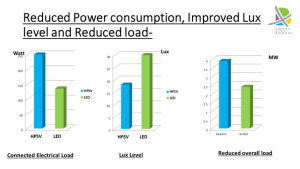
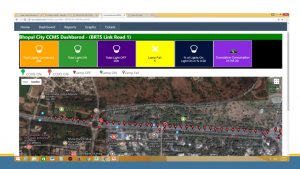
Smart Monitoring through ICCC
- All street lights are now connected to CCC and monitored at ICCC.
- In first 30 mins, each field engineer gets an alert and status on his mobile phone to check specific points for breakdown or repair.
- CCC gets an alert for breakdown and the repair requirements.
- Citizens can also lodge complaint via SCADL’s Citizen grievance redressal system.
- Each complaint is resolved within 48 hours.
- Citizens get an update and status of complaint via unique token number.
- The system provides various reports including device status (On/Off/Dim/Communication faults) location-wise, zone-wise and ward-wise.
- In case of an incident, system also provides data on status of on/off lights in day time for particular hrs.
- System provides data if pole is tilted at certain locations and alerts occur to concerned field engineer, thus saving time to rectify it on field.
- The additional aspect of data is that it also provides information on energy consumption including, if a particular light takes more than specified voltage power consumption then it reflects through the report and corrective actions can be taken based on power factor.
- Each smart light works on Astro timing, and based on drivers and sensors configured with smart lights, it leads to automatic on and off depending upon sunshine and sunset time.
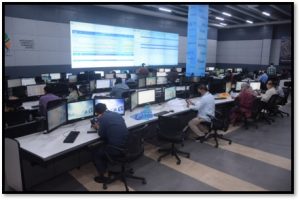

Output/Outcomes & Impacts
- LED lights are 40-60% more energy efficient than traditional lighting technologies
- With implementation of 1,45,404 LEDs, AMC have saved 2.78 Cr units of energy (cost saving INR 16.5 Cr).
- LEDs provide better quality lighting, lower energy consumption, and have reduced 14,000 tons of CO2 emissions.
- Brighter roads for increased public safety and new smart look by decorative brackets. Lux Levels increased by 25% and that too with significant decrease in power consumption.
- Adjusting light brightness level in areas where more accidents or criminal activities observed.
- Recent studies have shown that due to the installation of bright, white LED street lighting, crime rates have lowered. With less dark, un-illuminated pockets, people feel, and are, safer walking home late at night in comparison to when walking under traditional street lighting.
Way Forward
- Augmentation of 2,000 Street Lights as Smart Lights.
- BSCDCL has targeted to achieve more than 50% of its entire energy requirement to be fulfilled through renewable energy by 2022.
The biggest advantage of using LED lights is it can be used anywhere in the city:
- Entire city’s sodium Vapour lamps can be converted into LED lightings
- Many industries which operate 24*7 uses high amount of electricity, LED lights lights can help such industries in reducing their electricity bills.
- All the bus stations and in future metro stations can be converted into LED lightings, also Public Gardens and Libraries, Schools and Colleges, Stadiums and Grounds.
Therefore, the utility of these new lights can be realized everywhere, and the process of putting them into place is also straightforward. The phase is going to be replicated and readapted to regions across the city. The feasibility of implementation is also unproblematic, for the incurred costs are offset by long term operational savings. The costs have declined dramatically, more and more households, industries are installing LED which and they will save money over the long term.
 GOVERNMENT
OF INDIA
GOVERNMENT
OF INDIA
 GOVERNMENT
OF INDIA
GOVERNMENT
OF INDIA